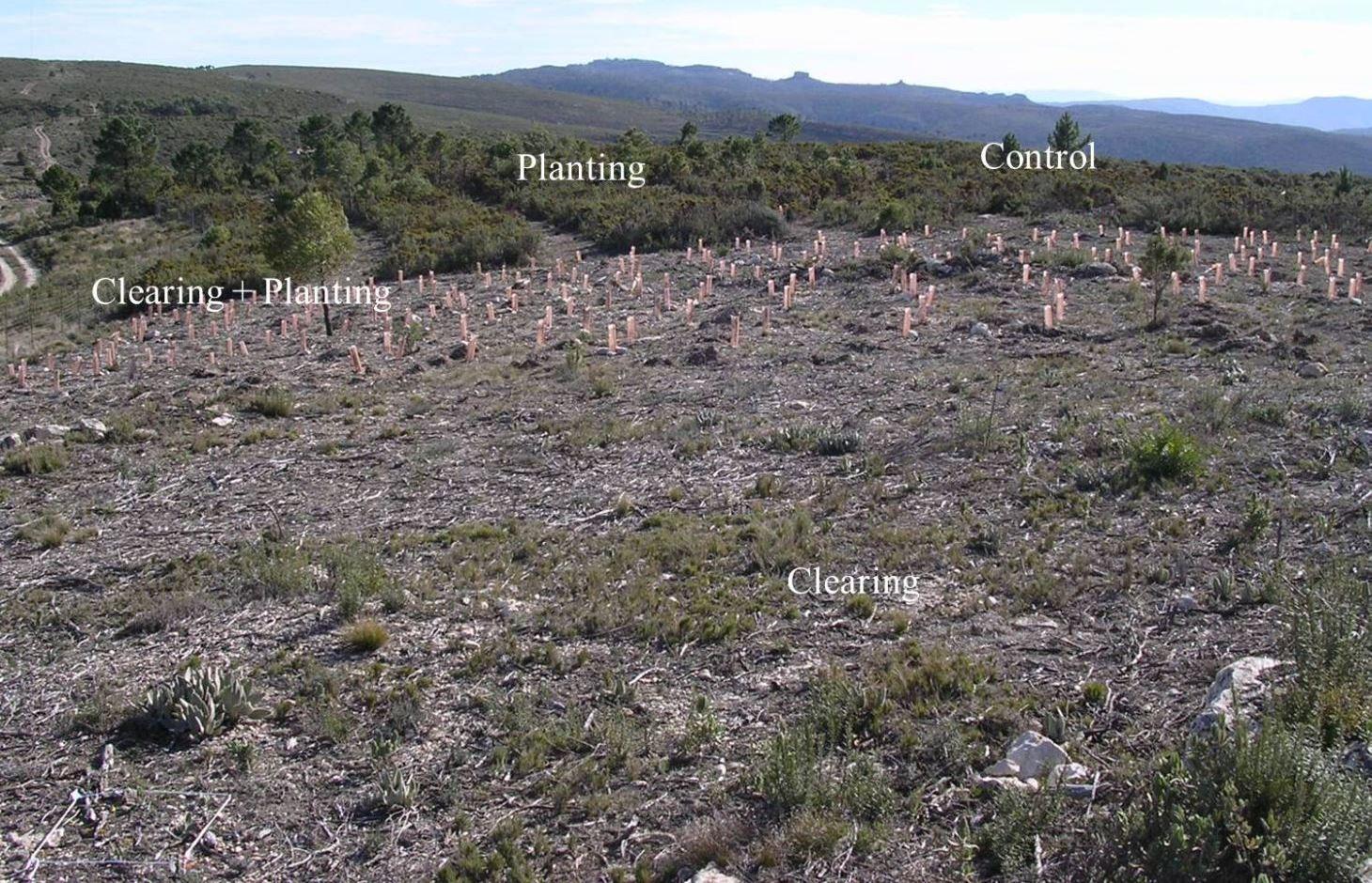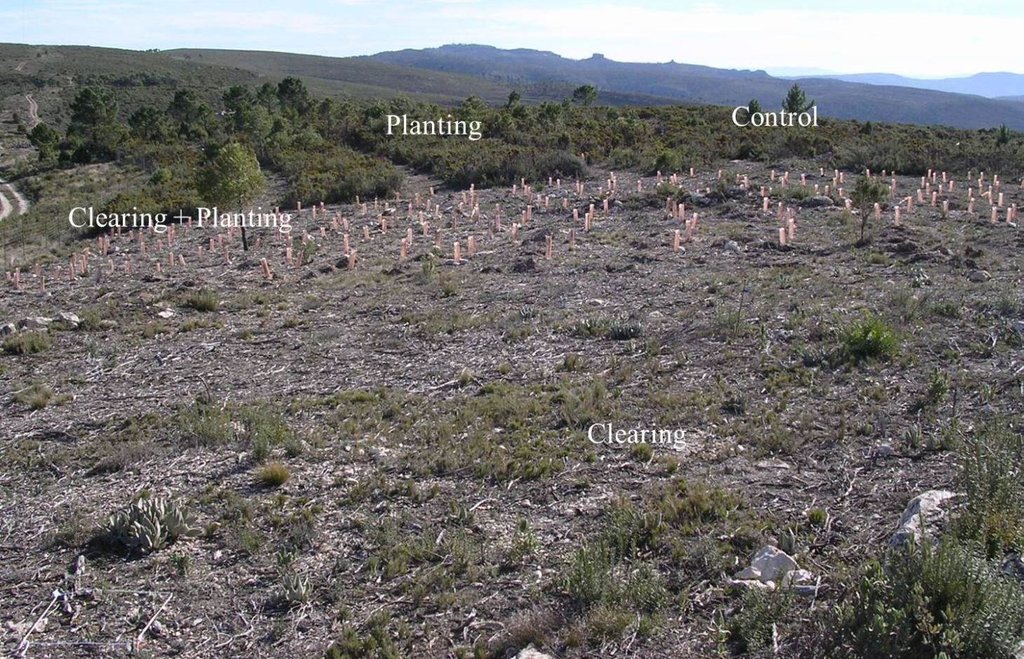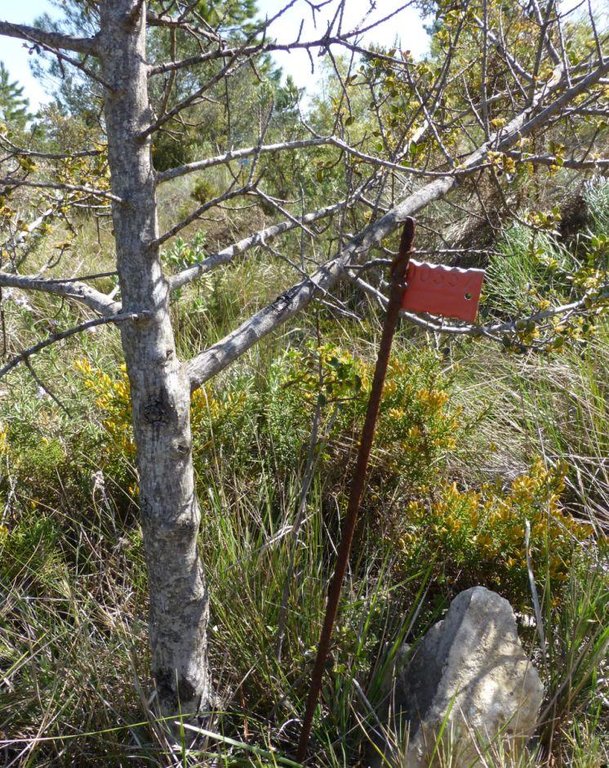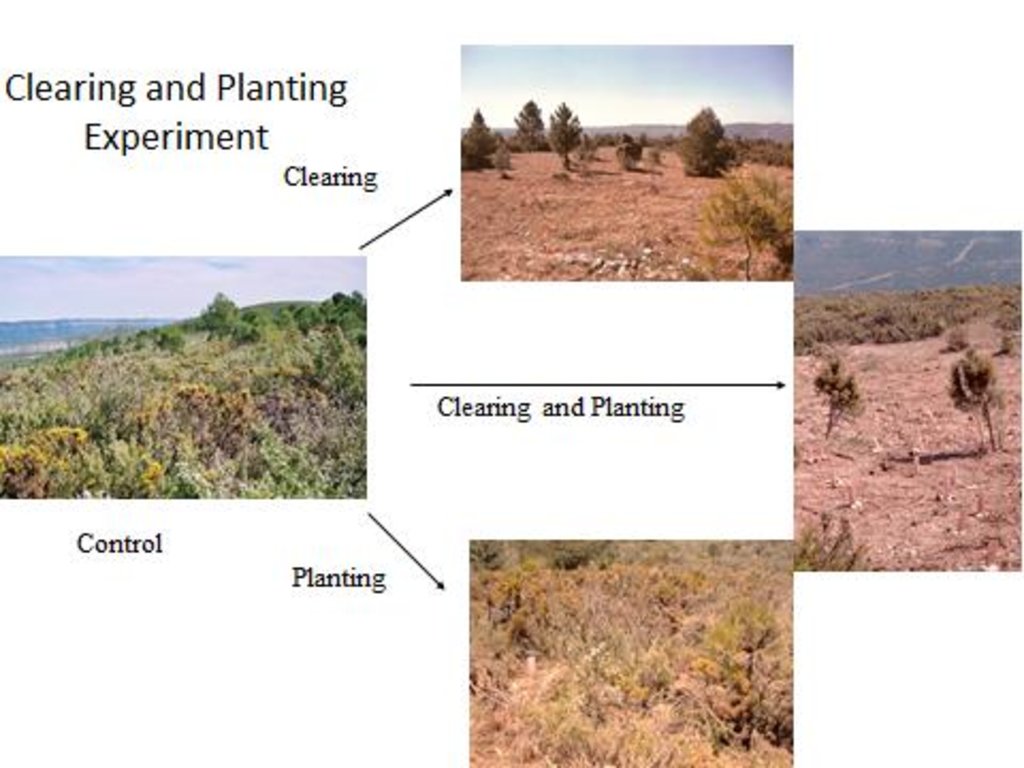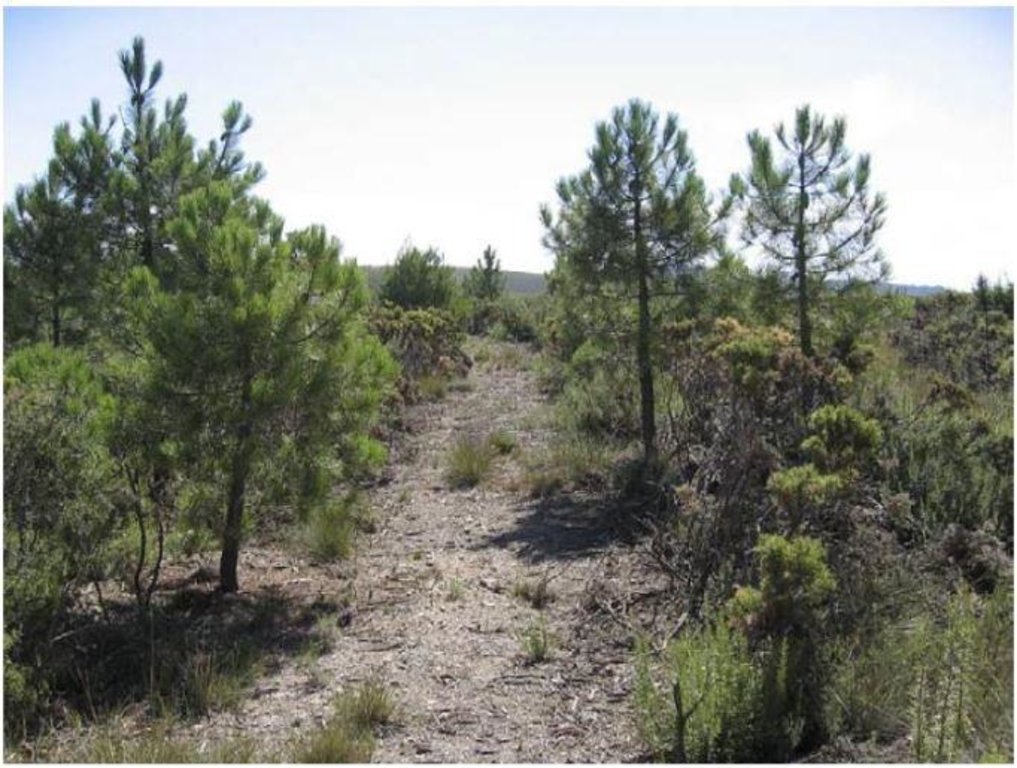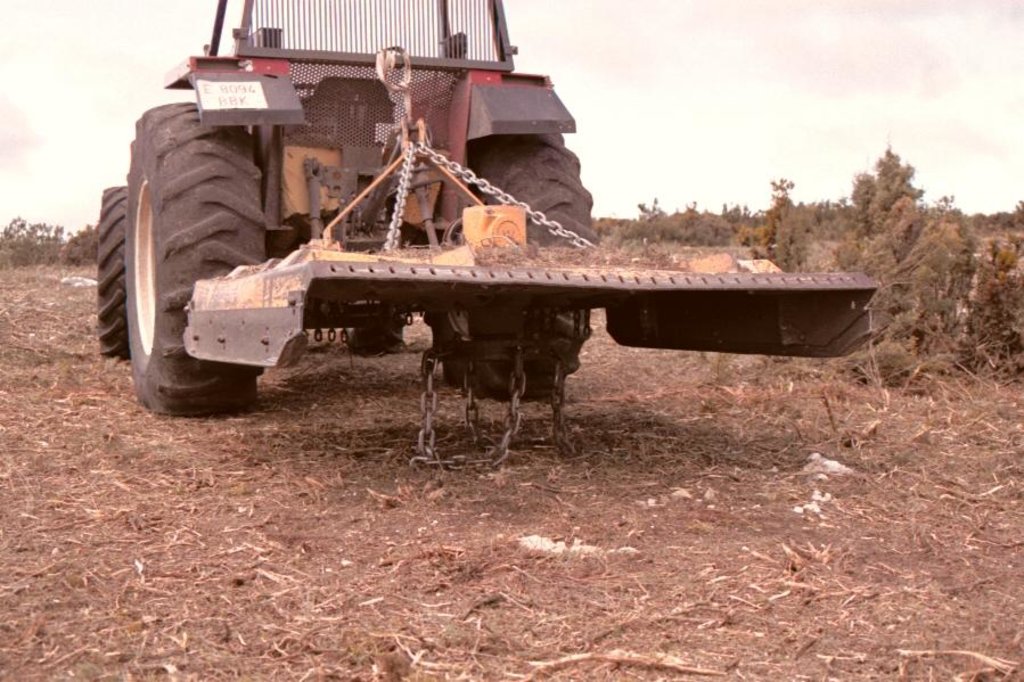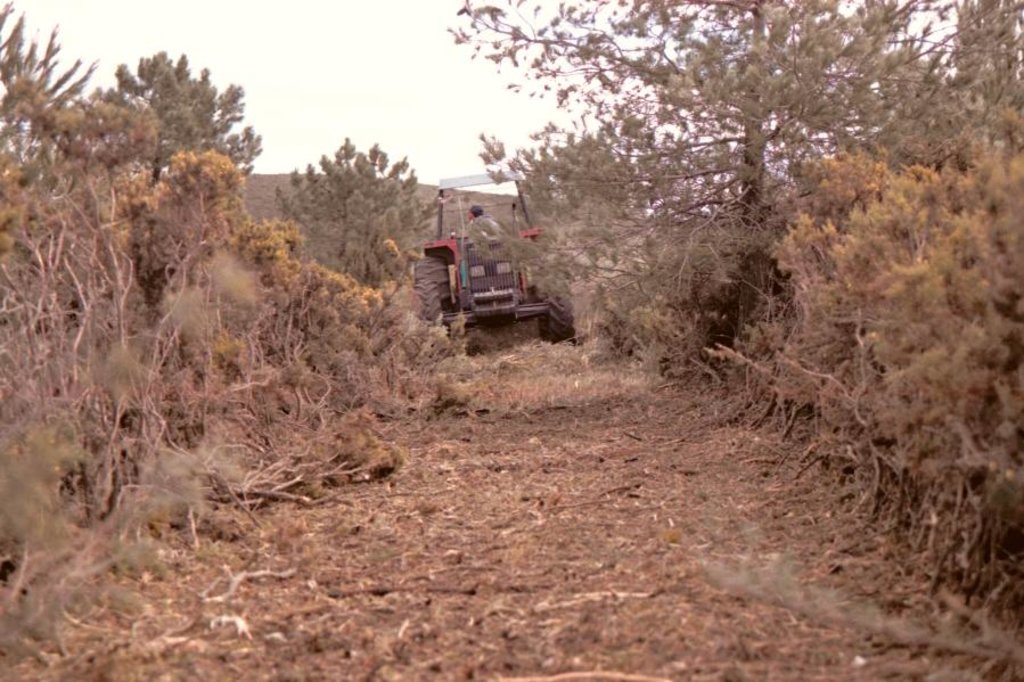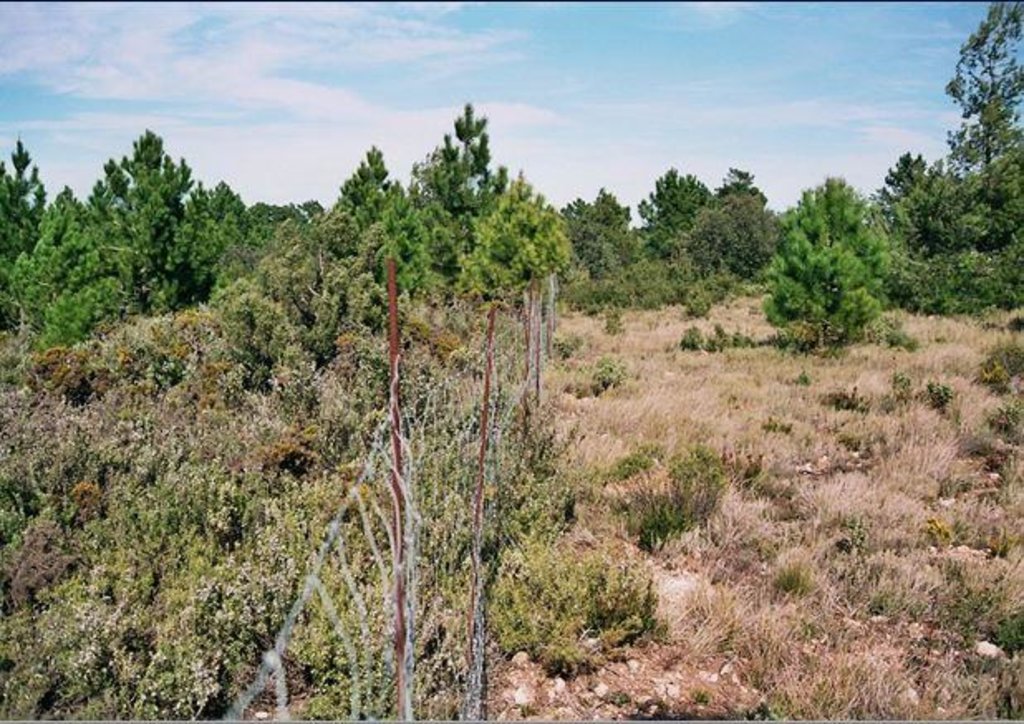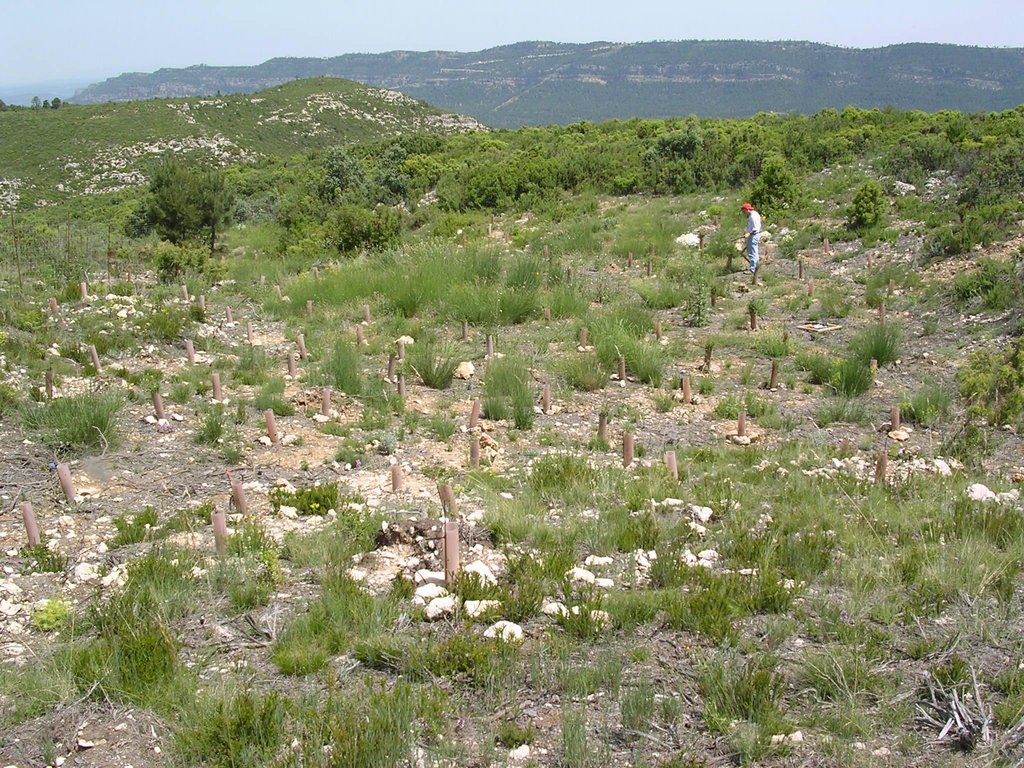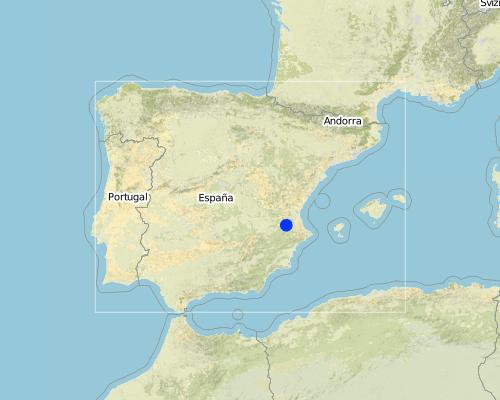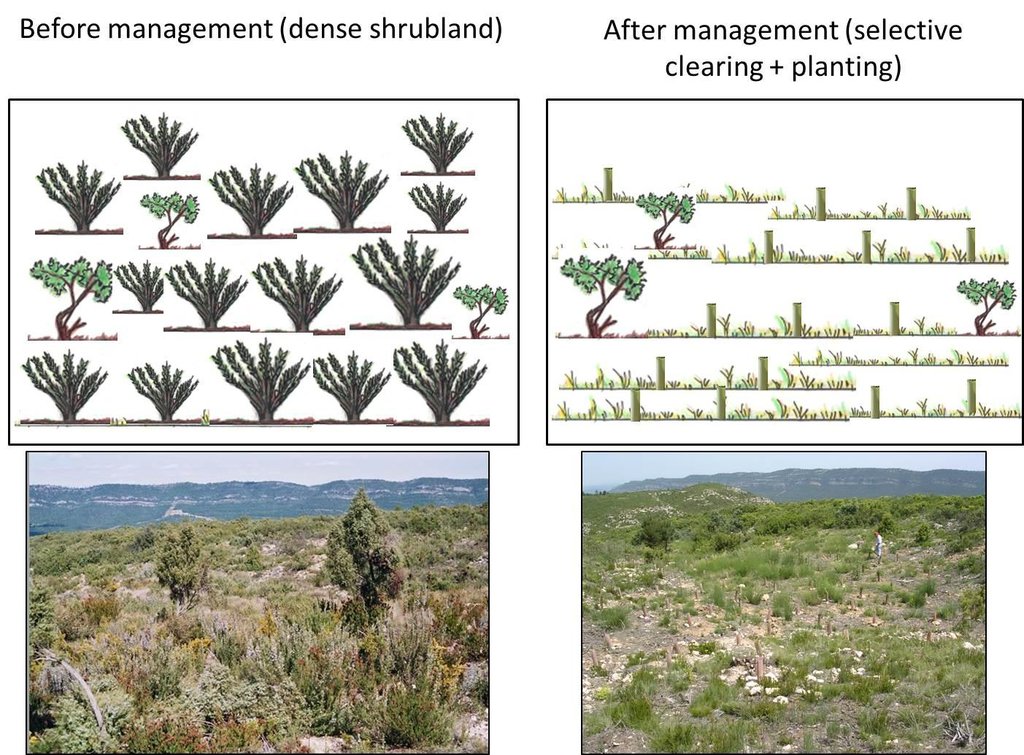Selective clearing and planting experiment to promote shrubland fire resilience [Spain]
- Creation:
- Update:
- Compiler: Nina Lauterburg
- Editor: –
- Reviewer: Deborah Niggli
Experimento para aumentar la resiliencia del matorral contra incendios (Spanish)
technologies_1579 - Spain
- Full summary as PDF
- Full summary as PDF for print
- Full summary in the browser
- Full summary (unformatted)
- Selective clearing and planting experiment to promote shrubland fire resilience: Jan. 4, 2017 (inactive)
- Selective clearing and planting experiment to promote shrubland fire resilience: July 30, 2019 (inactive)
- Selective clearing and planting experiment to promote shrubland fire resilience: Dec. 1, 2021 (public)
View sections
Expand all Collapse all1. General information
1.2 Contact details of resource persons and institutions involved in the assessment and documentation of the Technology
SLM specialist:
Valdecantos Alejandro
+34 609 183 599
a.valdecantos@ua.es
Fundación Centro de Estudios Ambientales del Mediterráneo (CEAM)
Parque Tecnológico Paterna. C/ Charles Darwin 14, 46980 Valencia, Spain
Spain
SLM specialist:
Baeza Jaime
jaime.baeza@ua.es
Fundación Centro de Estudios Ambientales del Mediterráneo (CEAM)
Parque Tecnológico Paterna. C/ Charles Darwin 14, 46980 Valencia, Spain. / Departamento de Ecología, Universidad de Alicante, Ap. 99, 03080 Alicante, Spain
Spain
Name of project which facilitated the documentation/ evaluation of the Technology (if relevant)
Catastrophic shifts in drylands (EU-CASCADE)Name of the institution(s) which facilitated the documentation/ evaluation of the Technology (if relevant)
Centro de Estudios Ambientales del Mediterraneo (CEAM) - Spain1.3 Conditions regarding the use of data documented through WOCAT
When were the data compiled (in the field)?
26/04/2013
The compiler and key resource person(s) accept the conditions regarding the use of data documented through WOCAT:
Yes
1.4 Declaration on sustainability of the described Technology
Is the Technology described here problematic with regard to land degradation, so that it cannot be declared a sustainable land management technology?
No
2. Description of the SLM Technology
2.1 Short description of the Technology
Definition of the Technology:
The combination of clearing of fire-prone seeder species and planting of more fire resistant resprouter species directs the vegetation to later successional stages which increases the resilience to fires.
2.2 Detailed description of the Technology
Description:
The forests and shrublands in Ayora experienced a series of disturbances in the past (such as deforestation and land use), which resulted in the degradation of the vegetation and the reduction of the resilience to fires. At present, there is a high fire incidence. Post-fire landscapes regenerated with a high and continuous fuel accumulation with few native resprouter species. Therefore appropriate vegetation management is crucial.
For management the major goals are to reduce the fuel load and its continuity and to increase the resilience of the vegetation to fires. Within this experiment carried out by CEAM (Centro de Estudios Ambientales del Mediterráneo, University of Valencia) different fuel management techniques were examined. They selected three study sites (Morera, Roñoso, Gachas) with a similar history of land use, vegetation composition, soil characteristics, and a typical post-fire scenario whith scarce occurrence of resprouter species. In each site, four plots were established to test the effect of the following management techniques: 1) control (no action), 2) clearing, 3) planting (within the shrubland) and 4) the combination of clearing and planting.
The main purpose of this experiment was to find out which management technique is the most appropriate to prevent fires and it was shown that the combination of selective clearing of fire-prone shrubs (fuel control) and planting of more resistant resprouter species can increase the resilience to fires and is therefore a suitable management practice. Compared to the other management techniques, there are some advantages. Clearing the vegetation (either by hand or mechanically) reduces the fire risk and enhances seedling establishment and growth. Furthermore, the cleared vegetation is chipped and applied in-situ as mulch, which protects the soil from erosion, reduces soil temperature and moisture loss, and enhances carbon conservation. Additionnally, selective clearing allows to preserve desired species and by planting resprouter species the natural processes can be accelerated. Once established, resprouter species persist for a long time which promotes an increase of the vegetation resilience.
In this documentation, only the combination of clearing and planting is evaluated since this action is considered as the most appropriate management practice.
In each study site, the experimental area covered about 5000m2 (3 plots of 1000m2 each, one plot of 2000m2). To test the effect of the combination of clearing and planting, a clearing machine was used to clear a plot of 1000 m2 in all three sites. The few resprouting individuals such as Juniperus oxycedrus and Quercus ilex and also some seeder trees such as Pinus halepensis and Pinus pinaster were left standing. The planting holes (0.35 m2) were created with a tractor using a backhoe. The slash and brush chips generated by the clearing were reused in the planting holes as mulch which resulted in ecological benefits.
In February 2003, native resprouters of late successional stages with a low amount of dead fuel were planted, such as Quercus ilex, Rhamnus alaternus and Pistacia lentiscus, all protected by a plastic tree shelter to prevent browsing.
The seedlings were grown for 8 months in a nursery in Santa Faz (Alicante) and then transferred to a nursery in La Hunde (Ayora) one month before planting. The Regional Forest Services of Valencia provided seeds as well.
The region of Ayora is mountainous with a dry subhumid climate (~380 mm annual rainfall). The risk of fire incidence is at its highest from June to September when there are adverse conditions like drought, high temperatures and strong winds (mainly the winds coming from central Spain, called “poniente”). The population density is very low and there are only few job opportunities (e.g. marginal agriculture, grazing, hunting, beekeeping). Most of the inhabitants work in the nuclear power plant. Forest management could be a source for jobs.
2.3 Photos of the Technology
2.5 Country/ region/ locations where the Technology has been applied and which are covered by this assessment
Country:
Spain
Region/ State/ Province:
Spain, Valencia
Further specification of location:
Ayora
Comments:
Boundary points of the Technology area: Morera Centre latitude (N): 39° 07’ 17’’ Centre longitude (W): 0°57’11’’
Roñoso Centre latitude (N): 39° 07’ 22’’ Centre longitude (W): 0°57’56’’
Gachas Centre latitude (N): 39° 01’ 58’’ Centre longitude (W): 0°53’30’’
Map
×2.6 Date of implementation
If precise year is not known, indicate approximate date:
- less than 10 years ago (recently)
2.7 Introduction of the Technology
Specify how the Technology was introduced:
- during experiments/ research
Comments (type of project, etc.):
This research was carried out in the framework of the SPREAD project funded by the European Commission (2002-2005), in the year 2003.
3. Classification of the SLM Technology
3.1 Main purpose(s) of the Technology
- reduce, prevent, restore land degradation
- reduce risk of disasters
3.2 Current land use type(s) where the Technology is applied

Forest/ woodlands
(Semi-)natural forests/ woodlands:
- Selective felling
Tree plantation, afforestation:
- Monoculture local variety
Products and services:
- Timber
- Fuelwood
- Fruits and nuts
- Other forest products
- Grazing/ browsing
- Nature conservation/ protection
- Recreation/ tourism
- Protection against natural hazards
- wind mill parc, hunting
Comments:
Major land use problems (compiler’s opinion): In Spain the prevalent dense shrublands (dominated by seeder species), which resulted from agricultural land abandonment and fire occurrence, contain a high fire risk because of both the high fuel loads and their continuity. Resprouter species have been removed in the past and are therefore scarce, whereas seeder species are abundant and increase the risk of fires.
Selective felling of (semi-) natural forests: As a management practice. The forest should be cut more frequently since there is a huge amount of fuel but there is no money for management.
Plantation forestry: Almost the whole forest in this region was planted. Furthermore, they also planted different species as a management practice.
3.3 Further information about land use
Number of growing seasons per year:
- 1
3.4 SLM group to which the Technology belongs
- natural and semi-natural forest management
- forest plantation management
3.5 Spread of the Technology
Specify the spread of the Technology:
- evenly spread over an area
If the Technology is evenly spread over an area, indicate approximate area covered:
- < 0.1 km2 (10 ha)
Comments:
Total area covered by the SLM Technology is 0.015 m2.
The experiment was done in three different gorseland test sites with similar history of land use, vegetation composition and structure, and soil characteristics – Morera, Roñoso, Gachas. In each site, there were 4 plots (control, clearing, planting, clearing and planting). Each site has an area of approximately 5000 m2 (total area: 5000 x 3 = 15’000 m2)
3.6 SLM measures comprising the Technology

vegetative measures
- V1: Tree and shrub cover
- V3: Clearing of vegetation
- V5: Others
Comments:
Specification of other vegetative measures: Introduction of fire resistant species
Type of vegetative measures: aligned: -linear
3.7 Main types of land degradation addressed by the Technology

biological degradation
- Bf: detrimental effects of fires
- Bs: quality and species composition/ diversity decline
Comments:
Main causes of degradation: deforestation / removal of natural vegetation (incl. forest fires) (Deforestation in the past (removal of resprouter species), land abandonment, uncontrolled growth of fire prone vegetation, afforestations, forest fires), other human induced causes (specify) (change of vegetation composition to fire-prone shrubland), population pressure (Vast areas were deforested in the past for agriculture, important key species were removed. After land abandonment there was a lack of management strategies.), poverty / wealth (The current economic crisis in Spain leads to a lack of investment in forest management, therefore only a minor part of forests is managed), labour availability (In the past there was outmigration from the region to the big cities and therefore there was a lack of management)
Secondary causes of degradation: change of seasonal rainfall (More variability in precipitation leads to a higher risk of fires), droughts (more fires during droughts), land tenure (The state is only allowed to apply management practices in public forest. The private forest is often not managed which increases the risk of fires and the resulting degradation), inputs and infrastructure: (roads, markets, distribution of water points, other, …) (There were big fires in the past because of the lack of fire extinction media like water ponds, streets, transport media (this has been improved now)), education, access to knowledge and support services (Loss of knowledge, important for today’s fires: People (especially from the cities) are not aware anymore of the risk of fire. In the past people lived with the risk and knew how to prevent fires.), governance / institutional (Law to induce implementation of conservation interventions (ley forestal 3/1993). Before this law was implemented there were less conservation practices and therefore a higher fire risk)
3.8 Prevention, reduction, or restoration of land degradation
Specify the goal of the Technology with regard to land degradation:
- prevent land degradation
- reduce land degradation
4. Technical specifications, implementation activities, inputs, and costs
4.1 Technical drawing of the Technology
4.2 Technical specifications/ explanations of technical drawing
On the left, the situation before management is illustrated. Dense shrublands contain a high fire risk due to their high fuel amount and continuity. On the right, the situation after management is shown. The combination of selective clearing of fire-prone seeder species and planting of more fire resistant resprouter species (illustrated by tree shelters in the drawing) promotes shrubland resilience to fires.
Location: Ayora. Valencia, Spain
Date: 13-12-2013
Technical knowledge required for field staff / advisors: high (The experiment was carried out by scientists (biologists) with a high technical knowledge.)
Technical knowledge required for land users: low (In case of upscaling this experiment to a local or regional level, the work could be carried out by land users with a low technical knowledge, with technical support of scientists and forest agents)
Main technical functions: control of fires, reduction of dry material (fuel for wildfires), Promotion of vegetation species and varieties (more fire resistant vegetation composition)
Secondary technical functions: control of raindrop splash, increase in nutrient availability (supply, recycling,…), increase / maintain water stored in soil
Aligned: -linear
Vegetative material: T : trees / shrubs
Number of plants per (ha): 1000
Vertical interval between rows / strips / blocks (m): <2m
Spacing between rows / strips / blocks (m): <2m
Vertical interval within rows / strips / blocks (m): <2m
Width within rows / strips / blocks (m): <2m
Vegetative measure: Selective vegetation clearing
Vegetative material: T : trees / shrubs
Trees/ shrubs species: Planted species: Pistacia lentiscus, Quercus ilex and Rhamnus alaternus.
Other species: Removed species: Ulex parviflorus, Rosmarinus officinalis, Cistus albidus
4.3 General information regarding the calculation of inputs and costs
other/ national currency (specify):
Euro
Indicate exchange rate from USD to local currency (if relevant): 1 USD =:
0.74
Indicate average wage cost of hired labour per day:
47.00
4.4 Establishment activities
| Activity | Type of measure | Timing | |
|---|---|---|---|
| 1. | Cutting and chipping (in-situ) trees and shrubs (removed species: ulex parviflorus, rosmarinus officinalis, cistus albidus. Natural regenerated species which are not cleared: pinus halepensis, pinus pinaster, quercus ilex, juniperus oxycedrus) | Vegetative | autumn/winter (when the vegetation activity is slowed down) |
| 2. | Planting (planted species: pistacia lentiscus, quercus ilex, rhamnus alaternus) | Vegetative | autumn/winter (february 2003) |
4.5 Costs and inputs needed for establishment
| Specify input | Unit | Quantity | Costs per Unit | Total costs per input | % of costs borne by land users | |
|---|---|---|---|---|---|---|
| Equipment | machine use | ha | 1.0 | 3089.0 | 3089.0 | |
| Equipment | tree shelters | ha | 1.0 | 945.0 | 945.0 | |
| Plant material | seedlings | ha | 1.0 | 4587.0 | 4587.0 | |
| Total costs for establishment of the Technology | 8621.0 | |||||
Comments:
Duration of establishment phase: 0.5 month(s)
4.6 Maintenance/ recurrent activities
| Activity | Type of measure | Timing/ frequency | |
|---|---|---|---|
| 1. | There is no maintenance, but in case of maintenance they would do selective clearings (using machines) | Vegetative | all 5-7 years in autumn/winter |
4.7 Costs and inputs needed for maintenance/ recurrent activities (per year)
| Specify input | Unit | Quantity | Costs per Unit | Total costs per input | % of costs borne by land users | |
|---|---|---|---|---|---|---|
| Equipment | machine use | ha | 1.0 | 446.0 | 446.0 | |
| Total costs for maintenance of the Technology | 446.0 | |||||
Comments:
The costs were calculated for the application of the technology (combination of clearing and planting) on one hectare. The costs can vary depending on the amount of vegetation which has to be cleared (site specific). The costs of the clearing amount to 1090 Euro per ha (1470 Dollar). The costs of the plantation (both labour and machines) are approximately 5300 Euro per hectare (7150 Dollar). But it should also be noted that the application of the selective clearing and planting on a vast continuous area is not the aim of this technology, but rather to apply the treatments on some selected spots to reduce the continuity of fire-prone seeder species and to increase the probability of dispersal of resprouter species (e.g. by birds). Therefore the costs would be lower than indicated here.
The currency rate (Euro-Dollar) was calculated on November 16th, 2013.
4.8 Most important factors affecting the costs
Describe the most determinate factors affecting the costs:
Slope (if the slope is steep, the work is much more difficult and takes more time), distance from a street (people can work less in a day if they have to walk far to clear/plant), vegetation density (it takes more time to clear a densely vegetated area).
5. Natural and human environment
5.1 Climate
Annual rainfall
- < 250 mm
- 251-500 mm
- 501-750 mm
- 751-1,000 mm
- 1,001-1,500 mm
- 1,501-2,000 mm
- 2,001-3,000 mm
- 3,001-4,000 mm
- > 4,000 mm
Agro-climatic zone
- sub-humid
Thermal climate class: temperate
5.2 Topography
Slopes on average:
- flat (0-2%)
- gentle (3-5%)
- moderate (6-10%)
- rolling (11-15%)
- hilly (16-30%)
- steep (31-60%)
- very steep (>60%)
Landforms:
- plateau/plains
- ridges
- mountain slopes
- hill slopes
- footslopes
- valley floors
Altitudinal zone:
- 0-100 m a.s.l.
- 101-500 m a.s.l.
- 501-1,000 m a.s.l.
- 1,001-1,500 m a.s.l.
- 1,501-2,000 m a.s.l.
- 2,001-2,500 m a.s.l.
- 2,501-3,000 m a.s.l.
- 3,001-4,000 m a.s.l.
- > 4,000 m a.s.l.
5.3 Soils
Soil depth on average:
- very shallow (0-20 cm)
- shallow (21-50 cm)
- moderately deep (51-80 cm)
- deep (81-120 cm)
- very deep (> 120 cm)
Soil texture (topsoil):
- fine/ heavy (clay)
Topsoil organic matter:
- medium (1-3%)
5.4 Water availability and quality
Ground water table:
5-50 m
Availability of surface water:
poor/ none
Water quality (untreated):
good drinking water
5.5 Biodiversity
Species diversity:
- medium
5.6 Characteristics of land users applying the Technology
Market orientation of production system:
- mixed (subsistence/ commercial
Individuals or groups:
- employee (company, government)
Gender:
- men
Indicate other relevant characteristics of the land users:
Difference in the involvement of women and men: The experiment was done by biologists, all of them were men.
Population density: < 10 persons/km2
Annual population growth: negative
5.8 Land ownership, land use rights, and water use rights
Land ownership:
- state
- individual, titled
Land use rights:
- individual
- public/open access but organised (e.g. wood, hunting)
- public/open access but organised (e.g. wood, hunting)
Comments:
There is some public land, controlled by the state. But there is also some private land. The access to the public land is open but organized. Permission is needed from the government to cut trees, to build a house or to hunt. There are some private hunting areas for which the hunting association has to pay a fee.
6. Impacts and concluding statements
6.1 On-site impacts the Technology has shown
Socio-economic impacts
Production
fodder production
Comments/ specify:
More grasses for animals (game and livestock) in the cleared areas
fodder quality
Comments/ specify:
Animals (especially goats) eat everything but they like more young grasses than shrubs
animal production
Comments/ specify:
Game/wildlife and livestock are better because there is an increase in fodder quantity and quality
wood production
Comments/ specify:
Production increases because there is less competition between species and more species planted. The wood/timber generated by the clearing can be used for biomass, fertilizers, pellets, firewood. A part of the wood is chipped in-situ and applied as mulch
energy generation
Comments/ specify:
Bioenergy (biomass)
Income and costs
expenses on agricultural inputs
Comments/ specify:
Less damage on the cultivated fields because the wild animals do not destroy the fields anymore and stay in the forest (because there is more grass available due to clearings).
Socio-cultural impacts
cultural opportunities
Comments/ specify:
People appreciate the visual impact of a cleared forest with a high species richness. It has a high aesthetic value and offers recreational opportunities. Since the planted species are more fire-resistant this value can be sustained.
recreational opportunities
Comments/ specify:
People appreciate the visual impact of a cleared forest with a high species richness. It has a high aesthetic value and offers recreational opportunities. Since the planted species are more fire-resistant this value can be sustained.
SLM/ land degradation knowledge
Comments/ specify:
Local people know about the importance of conservation of the area and really like to have the forest protected of wildfires. They will learn about the relationship of planting later-successional species and the reduction of the fire hazard.
conflict mitigation
Comments/ specify:
Less fires result in a decrease of the destroyed area, less money will have to be invested in restoration or fire extinction. Farmers, hunters,honey producers will experience fewer losses. Wild animals remain in the forest (more grasses after clearing).
situation of socially and economically disadvantaged groups
Comments/ specify:
The clearing and planting could create more job opportunities for unemployed people. This is especially important during the current economic crisis.
Ecological impacts
Water cycle/ runoff
evaporation
Comments/ specify:
Due to the mulch layer more moisture is stored in the soil and less water is lost by evaporation (the soil is covered).
Soil
soil moisture
Comments/ specify:
More soil moisture because of less dense shrubland and mulch cover after clearing
soil cover
Comments/ specify:
Mulch layer
soil loss
Comments/ specify:
Less erosion because the soil is protected by a mulch layer.
soil crusting/ sealing
Comments/ specify:
Mulch layer protects the soil from crusting.
nutrient cycling/ recharge
soil organic matter/ below ground C
Biodiversity: vegetation, animals
biomass/ above ground C
plant diversity
Comments/ specify:
Reintroduction of native species which disappeared due to removal by humans in the past.
animal diversity
Comments/ specify:
There might be more animals because of the fodder supply. Further, different species (e.g. birds) might be attracted by the reintroduced plant species.
pest/ disease control
Comments/ specify:
Mono-plantations are bad for the propagation of a pest. After clearing there is a decrease in competition, plants are in healthier conditions,less prone to diseases.Weak plants are eliminated which reduces the risk of pests (always weak plants affected).
Climate and disaster risk reduction
emission of carbon and greenhouse gases
Comments/ specify:
Carbon sequestration, and less fires because the fire-prone shrubs are removed and more fire-resistant trees and shrubs are prevalent
fire risk
Comments/ specify:
The fire risk is reduced in the long term because by clearing fire-prone and planting more fire-resistant species the vegetation is redirected towards later successional stages (ecosystem more resilient against fires).
wind velocity
Other ecological impacts
germination of competing seeds
soil surface temperature
Comments/ specify:
Mulch layer
6.3 Exposure and sensitivity of the Technology to gradual climate change and climate-related extremes/ disasters (as perceived by land users)
Gradual climate change
Gradual climate change
| Season | Type of climatic change/ extreme | How does the Technology cope with it? | |
|---|---|---|---|
| annual temperature | increase | not well |
Climate-related extremes (disasters)
Meteorological disasters
| How does the Technology cope with it? | |
|---|---|
| local rainstorm | well |
| local windstorm | well |
Climatological disasters
| How does the Technology cope with it? | |
|---|---|
| drought | well |
Hydrological disasters
| How does the Technology cope with it? | |
|---|---|
| general (river) flood | well |
Other climate-related consequences
Other climate-related consequences
| How does the Technology cope with it? | |
|---|---|
| temperature decrease, snow, frost | not well |
6.4 Cost-benefit analysis
How do the benefits compare with the establishment costs (from land users’ perspective)?
Short-term returns:
slightly negative
Long-term returns:
very positive
How do the benefits compare with the maintenance/ recurrent costs (from land users' perspective)?
Short-term returns:
very positive
Long-term returns:
very positive
Comments:
Short term returns are slightly negative because the management practice is expensive and until the trees reach a mature state, there are not many returns (in terms of wood and biomass). In the long term this management practice has very positive results because it increases the resilience to fires and can be seen as a sustainable management of fire-prone areas. Additionally, wood and biomass can be extracted. The idea is not to apply any maintenance in the first 10 years after the establishment.
6.5 Adoption of the Technology
Comments:
There is no adoption trend since this was only an experiment, but maybe there will be the possibility to upscale this technology in a regional project.
6.7 Strengths/ advantages/ opportunities of the Technology
| Strengths/ advantages/ opportunities in the land user’s view |
|---|
| Almost all villagers prefer a managed forest. It has a high aesthetic and recreational value. Through the application of this technology the awareness of the risk of wildfires would probably increase. |
| Shepherds and farmers benefit from forest clearings. There are more young grasses in the forest which provides fodder for livestock. Also wild animals benefit from this food supply which in turn hinders them to destroy cultivated fields of the farmers. |
| Strengths/ advantages/ opportunities in the compiler’s or other key resource person’s view |
|---|
|
After fires, the natural landscape regenerated with a high and continuous fuel amount and a scarce occurrence of native resprouter species. It is crucial to apply management actions to reduce the fire hazard. The experiment demonstrated that it is possible to accelerate the post-fire vegetation response (which promotes ecosystem resilience). |
| Planting of resprouting species in post-fire areas can accelerate the natural process. Clearing of the vegetation reduces the fire risk, but this treatment may also enhance seedling establishment and growth. |
| The slash and brush chips generated by the clearings can be reused in the planting holes. This mulch layer protects the soil surface and reduces both the soil surface temperature and the germination of competing seeds while increasing the soil moisture content, especially in the driest periods. |
|
The combination of clearing and planting resprouting species seems to be an appropriate option for managing these areas because, once established, the resprouting species persist for a long time and lead to an increase of the ecosystem resilience. |
| Social and economic benefits for the locals. Especially during the economic crisis the forest management is an important source for jobs. |
6.8 Weaknesses/ disadvantages/ risks of the Technology and ways of overcoming them
| Weaknesses/ disadvantages/ risks in the compiler’s or other key resource person’s view | How can they be overcome? |
|---|---|
| The management activities are expensive and labour-intensive. The state does not invest much money in prevention of forest fires but focuses more on fire extinction. | More investment in prevention of forest fires is required and this management practice could increase the ecosystem resilience against fires in the long term in a sustainable way. This would also generate jobs. This technology implies a combination of techniques (selective clearing and planting). Costs may be reduced by implementing individual techniques but positive results may also be reduced. |
| The technology could result in a reduction of the animal production because grazing should be restricted after planting to ensure the growth of the planted seedlings. | Since the technology would not be applied over vast areas but only locally on some plots, the fodder supply would probably still cover the needs of the animals. |
| Depending on the site, some soil may be exposed to erosion due to mechanical clearing. | Mulching with brush chipping can minimize or even solve this problem. |
| After clearing, an increase in wind velocity might occur. | The planted trees will grow which will again result in the reduction of this problem. |
7. References and links
7.1 Methods/ sources of information
- field visits, field surveys
- interviews with SLM specialists/ experts
7.2 References to available publications
Title, author, year, ISBN:
Valdecantos, A., Baeza, M.J., Vallejo, V.R. (2009): Vegetation management for promoting ecosystem resilience in fire-prone Mediterranean shrublands. Restoration Ecology 17, 3: 414-421.
Links and modules
Expand all Collapse allLinks
No links
Modules
No modules


